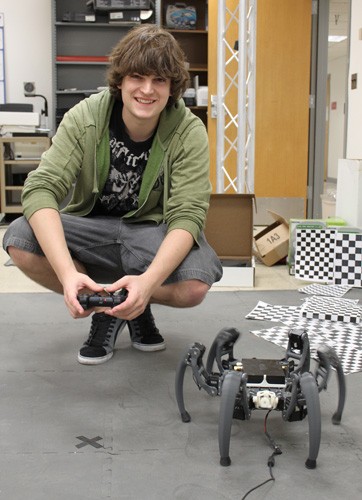Matt Bunting, an electrical engineering senior, built a robot that caught the attention of the Intel Corporation.
The hexapod robot looks like a spider and has a camera that can tell the robot if it is moving forward, sideways, backward or is tilting. It has the ability to analyze the video and “”learn”” how to move straight forward.
The robot was a class project last spring in Bunting’s cognitive robotics class, ECE 596C.
“”I’ve always wanted to build a hexapod, but I never had the excuse. I never had the time and money to spend on this until I had this class,”” Bunting said. “”I think the most exciting part of the project was hearing from Intel.””
Bunting’s professor, Tony Lewis, an associate professor of electrical and computer engineering, said if a leg or motor is malfunctioning, the robot can alter its movements so it can continue to move in a straight line. He added that the paradigm on which Bunting is working is a concept that can be applied to skills beyond just walking.
A video of the six-legged robot on YouTube was seen by Stewart Christie, a product marketing engineer with Intel’s Embedded and Communications Group in Chandler, Ariz. Christie asked Bunting to build two more similar robots using Intel’s Atom Z530 1.6 GHz processor or computer chip.
“”I put a message on the YouTube video asking if we could buy a couple of those things for marketing,”” Christie said.
Intel has about 150 sanctioned employees on Twitter, which is where Christie initially heard about the robot. Intel’s goal is to find compelling ways to market its computer chips.
“”It’s really difficult for us to find end products that are compelling for exhibition because the processors are embedded within them,”” Christie said.
He added that there might be lots of things, like cars or refrigerators, that use Intel chips, but people don’t know the brand of computer chip like they do with computers.
Christie said the robot is a great way to market Intel’s processor because the chip is not embedded in the robot.
Bunting agreed to build two more robots for Intel.
A 3-D printing company and CrustCrawler Robotics have also approached Bunting.
CrustCrawler Robotics is a company that develops and manufactures cutting-edge robots and robotic accessories. CrustCrawler wants Bunting to create software for the company’s next robotics kit.
Intel will use the robot at the Society of Women Engineers conference in Phoenix on Saturday. The robot will also be used at the Embedded World Conference in Nuremberg, Germany, held March 2 through 5, and at a university symposium in Milwaukee, Wis. during the second week of March.
“”He’s a real nice guy to work with,”” Christie said of Bunting.
Christie’s son went to the UA, and when he was visiting his son one weekend, he took a tour with Bunting and Lewis around the robotics lab at the UA.
“”It was quite impressive seeing this robot in person,”” Christie said.
Bunting brought his robot to Intel’s Phoenix office during a Halloween party where employees’ children were invited to trick-or-treat.
“”It’s scary enough for 3- and 4-year-olds,”” Chrisite said.
Christie said he was so impressed with Bunting that he is writing a letter of recommendation to Carnegie Mellon University’s graduate program.
Bunting said he enjoys finding solutions to problems and working in labs and could see himself being a research professor after he finishes graduate school.









